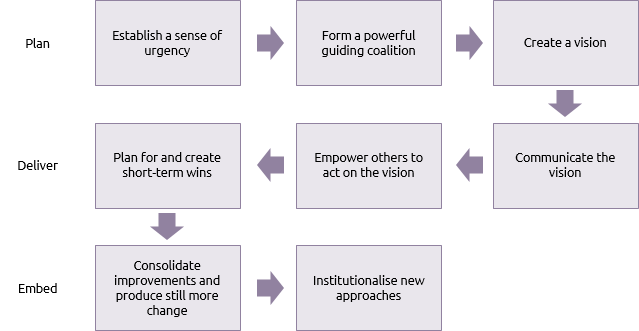In ‘Leading Change’, John Kotter1 introduced his “eight steps to transforming your organisation”.

The eight steps can be placed in three categories: plan, deliver and embed. These correlate to the phases and processes of the project/programme life cycle. The planning steps align with the identification process and the definition process, the deliver steps are synonymous with the delivery process and embed is a key element of benefits realisation.
The word ‘urgency’ suggests that things need to be changed in a rush and that is often very dangerous in project and programme management because mis-directed urgency often results in cutting corners in the P3M process. But what Kotter actually says is that this is about establishing the need for, and desirability of, the proposed changes.
Forming a ‘powerful guiding coalition’ is what stakeholder management and organisation management are all about.
The sponsor will have to use influencing skills to encourage powerful stakeholders to support the work. This may well result in the formation of a sponsoring group made up of key stakeholders with the sponsor at its head.
The vision is a standard document and provides a focus for communicating what the project or programme is trying to achieve.
As a result of stakeholder analysis a communication plan will show how the vision is to be communicated.
Empowering others to act on the vision is something that business change managers need to achieve within those parts of business-as-usual for which they are responsible.
The achievement of short term ‘quick wins’ is something that will greatly influence the organisation of tranches within a programme with the aim of creating an early sense of achievement.
As change is consolidated in order to achieve the required benefits, new benefits (and associated change) should be identified. This is built in to the benefits management procedure.
Ultimately, for the realisation of benefits to continue, the changes need to be institutionalised. To put that another way the changes cease to be seen as change and become the new ‘business-as-usual’.
In their book ‘Making Sense of Change Management’, Cameron and Green2 suggest that Kotter’s model is most applicable to Morgan’s ‘machine’, ‘political’ and ‘organism’ organisational metaphors.
- Kotter, J P (1995), Leading Change, Harvard Business School Press, Boston MA
- Cameron, E and Green, M (2009), Making Sense of Change Management, Kogan Page, London





